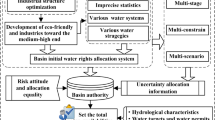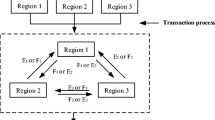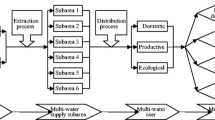Abstract
In recent decades, increasing conflicts have occurred between different water users because of issues related to water resource allocation. To better allocate water resources, this study adopts the latest water rights trading model instead of the traditional water resources allocation model and combines it with a two-stage interval-parameter stochastic programming model (TISP). The combined model was applied to the Sanjiang Plain with multi-area, multi-source, and multi-water users, and the optimized promised water availability for every user in the area was obtained. The analysis shows that a higher promised water availability corresponds to a higher benefit but also promotes additional risks because of water shortages, whereas a lower promised water availability corresponds to a lower benefit, although it is more likely to result in water waste at high inflow levels. The combined model formed an effective link between water use benefits and water deficiency punishments that enabled us to obtain an optimized promised water availability that considers benefits and risks simultaneously. The second result is that the water rights trading model can improve the utilization efficiency of water resources, which are typically transferred from inefficient water use areas to efficient water use areas, resulting in a benefit to all areas. Additionally, in the water rights trading model, self-profit motivation at a micro-level can emerge in adaptation at a macro-level, which stabilizes the water resource system and reduces the possibility of system collapse because of extreme water shortages.





Similar content being viewed by others
References
Bekchanov M, Bhaduri A, Ringler C (2013) How market-based water allocation can improve water use efficiency in the Aral Sea basin? ZEF-Discuss Papers Dev Policy (177)
Brookshire DS, Colby B, Ewers M, Ganderton PT (2004) Market prices for water in the semiarid West of the United States. Water Resour Res 40(9):W09S04
Chang-jie LI, Xian-jia W, Wen-tao FAN (2007). Design of mechanism and bayesian model of water rights market. Syst Eng Theor Pract (05) 90–94
Cheng K, Fu Q, Chen X, Li T, Jiang Q, Ma X, Zhao K (2015) Adaptive allocation modeling for a complex system of regional water and land resources based on information entropy and its application. Water Resour Manag 29(14):4977–4993
Cohen Liechti T, Matos JP, Boillat J-L, Schleiss AJ (2014) Influence of hydropower development on flow regime in the Zambezi River Basin for different scenarios of environmental flows. Water Resour Manag 29(3):731–747
Dinar A, Rosegrant M, Meinzen-Dick R (1997) Water allocation mechanisms. World Bank: Policy Research Working Paper 1779, Washington
Easter KW, Rosegrant MW Dinar (1998) Markets for water: potential and performance (Vol. 15), Springer Science & Business Media
Etchells T, Malano H, McMahon TA, James B (2004) Calculating exchange rates for water trading in the Murray-Darling Basin, Australia. Water Resour Res 40(12), W12505
Ferrero RW, Rivera JF, Shahidehpour SM (1998) A dynamic programming two-stage algorithm for long-term hydrothermal scheduling of multireservoir systems. IEEE Trans Power Syst 13(4):1534–1540
Gu JJ, Huang GH, Guo P, Shen N (2013) Interval multistage joint-probabilistic integer programming approach for water resources allocation and management. J Environ Manag 128:615–624
Huang GH (1996) IPWM: an interval parameter water quality management model. Eng Optim 26(2):79–103
Huang GH, Baetz BW, Patry GG (1994) Grey dynamic programming for waste‐management planning under uncertainty. J Urban Plan Dev 120(3):132–156
Kovács L, Boros E, Inotay F (1986) A two-stage approach for large-scale sewer systems design with application to the Lake Balaton resort area. Eur J Oper Res 23(2):169–178
Li YP, Huang GH (2006) An inexact two-stage mixed integer linear programming method for solid waste management in the City of Regina. J Environ Manag 81(3):188–209
Li CY, Zhang L (2015) An inexact two-stage allocation model for water resources management under uncertainty. Water Resour Manag 29(6):1823–1841
Livingston ML (1995) Designing water institutions: market failures and institutional response. Water Resour Manag 9(3):203–220
Maqsood I, Huang G, Huang Y, Chen B (2005a) ITOM: an interval-parameter two-stage optimization model for stochastic planning of water resources systems. Stoch Env Res Risk A 19(2):125–133
Maqsood M, Huang GH, Yeomans JS (2005b) An interval-parameter fuzzy two-stage stochastic program for water resources management under uncertainty. Eur J Oper Res 167(1):208–225
Moiwo JP, Tao F (2014) Evidence of land-use controlled water storage depletion in Hai River Basin, North China. Water Resour Manag 28(13):4733–4746
Pereira MVF, Pinto LMVG (1985) Stochastic optimization of a multireservoir hydroelectric system: a decomposition approach. Water Resour Res 21(6):779–792
Ringler C (2001) Optimal allocation and use of water resources in the Mekong River Basin: multi-country and intersectoral analyses (Vol. 20): P. Lang
Rosegrant MW, Binswanger HP (1994) Markets in tradable water rights: potential for efficiency gains in developing country water resource allocation. World Dev 22(11):1613–1625
Rosegrant MW, Schleyer RG (1996) Establishing tradable water rights: implementation of the Mexican water law. Irrig Drain Syst 10(3):263–279
Seifi A, Hipel KW (2001) Interior-point method for reservoir operation with stochastic inflows. J Water Resour Plan Manag 127(1):48–57
Sun XT (2009) Introduction: the development of a water rights system in China. Int J Water Resour Dev 25(2):189–192
Tisdell JG (2001) The environmental impact of water markets: an Australian case-study. J Environ Manag 62(1):113–120
Wang D, Adams BJ (1986) Optimization of real-time reservoir operations with Markov decision processes. Water Resour Res 22(3):345–352
Wang HR, Dong YY, Wang Y, Liu Q (2008) Water right institution and strategies of the Yellow River Valley. Water Resour Manag 22(10):1499–1519
Xie YL, Huang GH (2013) An inexact two-stage stochastic programming model for water resources management in Nansihu Lake Basin, China. J Environ Manag 127:188–205
Zhang L, Li CY (2014) An inexact two-stage water resources allocation model for sustainable development and management under uncertainty. Water Resour Manag 28(10):3161–3178
Zhang JL, Zhang FR (2008) Mutual monitoring in a tradable water rights system: a case study of Zhangye City in Northwest China. Agric Water Manag 95(3):331–338
Zhang LH, Jia SF, Leung CK, Guo LP (2012) An analysis on the transaction costs of water markets under DPA and UPA auctions. Water Resour Manag 27(2):475–484
Acknowledgments
This research has been supported by funds from national natural science foundation of China (51179032, 51279031, 51209038, 51479032, 51579044); Program for new century excellent talents in university(NCET-11-0952); Scientific research projects of public welfare industry of Ministry of Water Resources (201301096); Initial capital for doctors of Northeast Agricultural University (2012RCB58).
Author information
Authors and Affiliations
Corresponding author
Ethics declarations
Conflict of interest
The authors declare that they have no conflict of interest.
Rights and permissions
About this article
Cite this article
Fu, Q., Zhao, K., Liu, D. et al. The Application of a Water Rights Trading Model Based on two-Stage Interval-Parameter Stochastic Programming. Water Resour Manage 30, 2227–2243 (2016). https://doi.org/10.1007/s11269-016-1279-9
Received:
Accepted:
Published:
Issue Date:
DOI: https://doi.org/10.1007/s11269-016-1279-9




